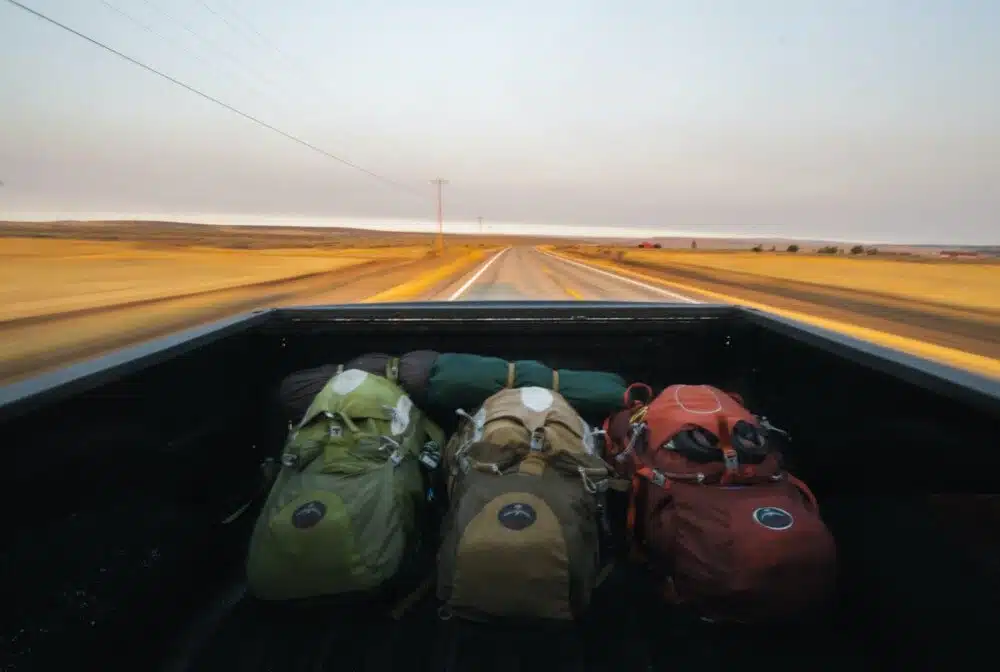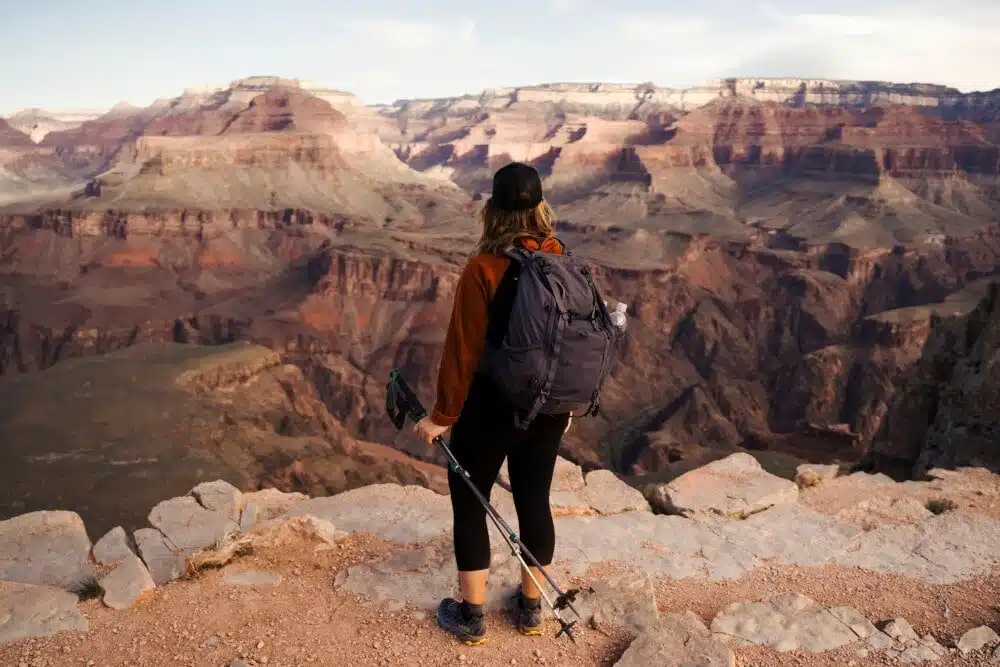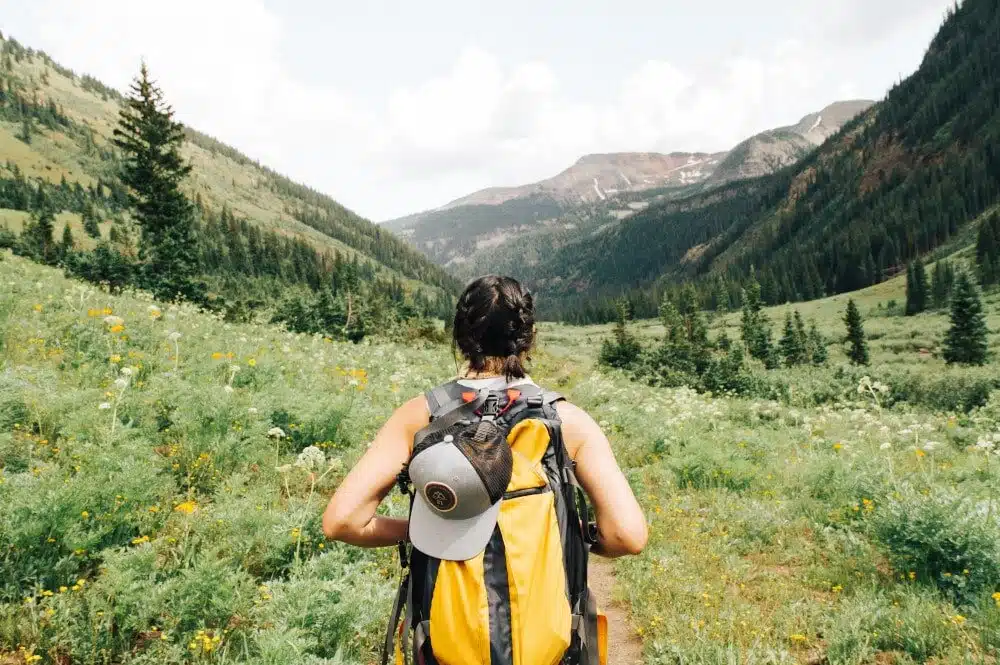I hope this guide to the different types of backpacks helps you find one to suit your needs.
It boggles the mind how many different types of backpacks line the shelves nowadays.
They come in all sizes, shapes, and backpack styles, with wide-ranging functions, features, and fittings!
It’s a mixed blessing.
With so many backpack types to choose from, it’s harder to know which one’s right for your needs.
That’s why I put together this guide to the 18 different kinds of backpacks.
With any luck, it’ll help you pick the perfect pack!
[Last Updated: June 2023]
Heads up, this post contains affiliate links.
18 Different Backpack Types – Order of Contents
- Frame Backpack/Hiking Backpack
- Frameless Backpack
- Dry-Bag Backpack
- Backpacking Backpack
- Carryon Backpack
- Minimalist Backpack
- TSA Friendly Backpack
- Daypack (Sightseeing Daypack)
- Wheeled Backpack
- Drawstring Backpack
- Hydration Backpack
- Snowsports Backpack
- Climbing Backpack
- Shoulder Bag/Rucksack
- Sling Bag
- Mini Backpack
Here we go: the different backpacks and their respective pros and cons!
18 Different Backpack Styles & Uses
There are all kinds of backpacks available on the shelves! I’ve narrowed them down to 18 different types of backpacks to choose from.
I’ve divided the coming list into 4 categories: Outdoor/Hiking backpacks, Travel Backpacks, Sports Backpacks, & Casual/Everyday Backpacks. I hope you find it useful!
You might also like this post about how to waterproof a backpack.
A. Outdoor/Hiking Backpacks
Hiking backpacks are ideal for anybody who loves to spend time in the great outdoors.
They’re designed for the rigors of the trail- with durable materials, specialized attachments and compartments, and specific attributes that lend themselves to expeditions.
Here are 4 primary types of outdoor/hiking backpacks you’ll find:
1) Frame Backpack/Hiking Backpack
A hiking backpack with an internal frame is designed and built for long stints in the outdoors. They’re also great for travelling.
These types of backpacks come in various sizes, and each brand offers its own array of novel features. In general, though, they’re rugged packs with:
- Padded shoulder straps (for comfort)
- A padded waist belt (for comfort and load-bearing)
- A ventilated back panel (to stop you sweating so badly), and
- Various loops, fixtures, and compartments for your hiking gear
The internal frame offers rigidity, support, and stability that helps spread the load you’re carrying. However, it also adds weight.
These packs will often have a waterproof rain cover attached as well, just in case you get caught in a downpour.
If they don’t come with one, I recommend buying one separately.
The exact size you need depends on the treks you’ll be doing. Multi-day hikes, for example, demand more gear and supplies, which means a bigger pack (think upwards of 50-60L upwards).
For shorter hikes, you can get away with a smaller hiking backpack.
Whether you choose one with a frame or not is up to you!
It’s a matter of preference, as well as the balance between weight and support. Frames deliver more of both.
Top Pick for Men: Berghaus Trailhead 65L
Top Pick for Women: Osprey Renn 50L
2) External Frame Backpack
You can also find large hiking backpacks with external frames.
These types of backpacks lend themselves to greater personalization and offer better ventilation as they sit further away from your back.
However, they’re usually bigger, bulkier, and more cumbersome to wear. The frame can get snagged more easily on passing branches etc on the trail as well.
3) Frameless Backpack
Frameless backpacks are pure fabric!
There’s no metal ‘stays’ running down the back, which means you can roll and fold them up.
It also means they’re super lightweight, which is good news for ultralight hikers, campers, or even travellers.
But you undeniably sacrifice the support of framed versions. With no frame to help distribute the weight, the pack pulls on your shoulders and can cause more back pain.
For heavy loads (the definition of ‘heavy’ varies by person, but let’s say 15 to 20 lbs or above), a framed backpack is probably better for the job.
However, for lighter loads, frameless backpacks can be a great way forward for hikers.
Top Pick: Speedo Tri Clops Backpack 50L
4) Dry Bag Backpack
Dry bag backpacks live up to their name!
They’re designed to be sturdy, durable, fully-waterproof packs. The materials are thick, impermeable, and are sure to keep everything inside as dry as a bone.
These types of backpacks often fold over at the top and clip together to create a fully water-tight seal.
Typical packs don’t offer the same level of waterproofing. The materials are water-resistant at best and become sodden in heavy downpours.
That’s not the case with dry-bag backpacks.
They’re ideal for any water-based activities as well, such as kayaking, paddle boarding, or fishing. Whenever you expect to get wet (even if you’re only commuting to work or class), a dry-bag backpack is the way to go.
However, they usually lack the versatility and comfort of traditional hiking backpacks. Expect the shoulder pads to have minimal padding and the waist strap (if there even is one) to be thin.
Top Pick: Earthpak Roll-Top Dry Bag (up to 55L)
Time to move onto the best kinds of backpacks for travel!
B. Travel Backpacks (The Classic Styles of Backpacks)
Travellers take hiking backpacks around the world and hikers take travel backpacks on the trail. Why?
Because they’re essentially the same thing!
However, there are certain differences to keep in mind.
For instance, there are particular features and accessories that are necessary on the trail but not on the road, and vice versa. Likewise, I’d argue that all hiking backpacks would make reasonable travel backpacks, but not the other way around!
As you’ll see, certain travel bags would be horrendous out in nature.
Yet, for all intents and purposes, you’d be fine with a hiking backpack (namely the framed ones) when travelling.
With all that said, here are 7 types of travel backpacks and their relative uses, pros and cons.
5) Backpacking Backpack
Heads up, by ‘backpacking’, I’m talking about long term global travel with a backpack as your primary form of luggage- not the act of going out into the wilderness for a trek.
Having said that, backpacking backpacks could well be used for both! And, to be fair, I think most people (most people) see and use them as essentially the same thing anyway.
These packs tend to be hardy, durable, (relatively) waterproof, and have sufficient space to store and transport your stuff on the road.
More often than not, there’s an internal frame, one primary compartment for your things, and numerous extra pockets and features that come in handy when travelling.
You’ll come across two primary options: top and front loading.
Top loading packs are the classic style, where you pack your things from the top via a single point of entry that seals via a drawstring.
Front loading (sometimes known as ‘panel loading’) packs have a front panel that opens up like a suitcase via a zipper.
There are pros and cons to both!
I travel with a top-loading backpack because they’re usually thinner and more compact. However, there’s no denying the convenience of a front-loading pack, which makes loading and unloading your bag a breeze.
Top Pick (Top Loading): Osprey Atmos 65L
Top Pick (Front Loading): Osprey Prior Season 46L
6) Carryon Backpack
Carryon backpacks are smaller bags that you can take with you onto a plane.
Of course, all sorts of different bags fit that description. In effect, any bag with straps that’s small enough to qualify as hand luggage would count as a carryon backpack!
There’s a bit more to it than that.
For instance, the size of the bag makes a key difference.
The best carryon backpacks give you the maximum amount of room possible without going over the limits set by airlines. Generally speaking, that means 40L of space (though the exact dimensions vary by airline).
Many people travel with these as their one and only form of luggage. They travel light, fitting everything into 40L of space in order to avoid expensive hold luggage fees.
If you aim to do the same, make sure you select a pack that’s durable, and has a quality waist belt and padded shoulder straps too.
Top Pick: Osprey Farpoint 40
7) Minimalist Backpack
I see minimalist backpacks as a subset of carryon backpacks.
They’re usually no larger than 40L, which makes them ideal for the plane, and offer a great combination of aesthetics and functionality. I personally like minimalist backpacks because they’re sleek, no-nonsense, and come with a wide array of compartments and features.
They’re ideal for commuters, digital nomads, and short term travellers alike (though there’s nothing stopping you taking them on long term trips as well).
Here’s my guide to the best minimalist backpacks.
Top Pick: Hynes Eagle 40L
8) Smart Backpacks
Smart backpacks are a bit like minimalist backpacks, but with a few extra gizmos and functions.
They’re sleek, simple, durable bits of kit that’d be great as carry-on luggage for digital nomads, or anybody carrying lots of technology on the road.
You’ll enjoy extra functionality, such as USB ports, power banks, and solar chargers to help you charge up your tech on the move. They also tend to have security systems to protect the gear you’re carrying.
Sound good? Check out my guide to the best smart backpacks.
Top Pick: Tzowla Waterproof Laptop Backpack with USB Charging Port
9) TSA Friendly Backpack
A TSA friendly backpack (also known as a checkpoint-friendly backpack) is one that you can leave your laptop inside as you go through airport security.
You’d normally have to take out your laptop and pop it into a separate tray to go through the fancy x-ray machine.
Speaking from experience, this takes time and effort, which is annoying when you’re in a rush to catch a plane.
I’ve never tried these bags and have no idea if they work! In theory, though, it’d be a nice little time-saver. They also seem like well-made packs with quality materials and a host of handy tech-related compartments.
All told, they’d make great carryon backpacks for anybody travelling with a laptop.
Top Pick: Swissgear 1900 ScanSmart TSA Laptop Backpack
10) Daypack (Sightseeing Daypack)
Daypacks are small, super lightweight, and ideal for days out in new locations.
Many people on the road actually use their carryon to function as a daypack. After all, they can be small, easy to carry, and made from good-quality materials.
However, not every carryon fits that description. Some are remarkably large and even come in suitcase form.
That’s where it pays to have a designated daypack.
You’re usually looking at a 20-25L frameless pack that folds up to be brought out when you need it. If you travel with a big backpacking backpack, then you might have a daypack to take with you onto the plane. This is my usual setup, and has served me well so far.
Top Pick: HIKPRO 20L
11) Wheeled Backpack
Wheeled backpacks are a suitcase-backpack hybrid!
You can use the straps to carry it around like an ordinary backpacking backpack, or expand the telescopic arms to drag it around on its wheels.
That’s handy when you’re covering longer distances and don’t fancy lugging around a giant pack on your shoulders.
This is one example of a travel backpack that you wouldn’t want to take on a hike though! The straps (and overall design), though helpful in some circumstances, just aren’t made for transporting heavy loads on your shoulders for miles on end over rough terrain.
I’d never take a wheeled backpack on the trail!
I would, however, be tempted to take one travelling, where lugging an ordinary backpack on your shoulders can get tiring, cumbersome, and uncomfortable.
Top Pick: Matein Rolling Backpack
Onto the different sports backpacks you can come across out there!
C. Sports Backpack
Sports backpacks are, as you’d expect, useful for sporting endeavors.
In essence, though, they’re just daypacks with specific features and modifications that make them ideal for sports (be it sports in general, or a particular sport in question).
Here are 4 sports backpacks and their uses, pros, and cons.
12) Drawstring Backpack
Most people have come across drawstring backpacks at one point or another in life.
They’re simple, small, lightweight bags with a drawstring that pulls them shut. They’re handy for the gym, or for taking to sports practice of any kind.
However, I wouldn’t say they’re great for much else! The straps tend to be thin and uncomfortable to wear, they’re unlikely to be waterproof, and they provide limited space for your things.
FYI, I’ve listed these as a sports backpack. However, you can definitely find drawstring bags that aren’t great for sports! It’s a common design for casual rucksack-style backpacks- more on these later.
Top Pick: Under Armour Undeniable 2.0
13) Hydration Backpack
A hydration backpack is specially designed to hold a water/hydration bladder (such as a camelback), with a hose attachment from which you drink.
They’re simple, lightweight packs designed to help you transport fluid and drink with ease when you’re out and about. You’d use them for running, trail running, day hikes, and any other such instances.
Aside from a few small zippered pockets, though, you wouldn’t be able to transport much more than the bladder itself.
Top Pick: Unigear Tactical Hydration Backpack (with Bladder)
14) Snowsports Backpack
You can probably guess what these backpacks are designed for!
Anybody going skiing or snowboarding could consider buying a snowsports backpack. They’re tough, durable, waterproof bags with special fittings to help transport your gear. Attach your snowboard or ski poles and enjoy easy-access stash pockets for spare clothes/snacks, and so on.
In general, though, they’re pretty similar to small hiking backpacks. They’ve got the same shoulder strap/waist belt combination and materials that are well-suited to the rigours of the outdoors.
Top Pick: Dakine Poacher 14L
15) Climbing Backpack
Climbing backpacks are, of course, designed to accompany climbers on their expeditions.
The exact style of pack you need depends on the nature of the climbing/expedition you’ll be doing. Generally speaking, though, you’re looking at a durable piece of kit that makes organisation easy and offers a host of fittings from which to attach your climbing gear.
Love climbing? Check out the best climbing documentaries ever made.
Top Pick: Petzl Bug Climbing Backpack
Time to finish with a selection of everyday backpacks that are perfect for everyday use.
D. Casual/Everyday Backpack
I’ll finish with everyday backpacks that people might use in “ordinary life”.
The following packs wouldn’t be ideal for hiking, travel, or sports, but they’d come in handy for any number of everyday activities!
16) Rucksack/Knapsack
Rucksacks are your quintessential backpack that you might have taken to school in the past!
They’re basic bits of kit, with a main compartment and (perhaps) one or two additional pockets for easy access to certain items of choice. You might have a zipper or drawstring to close the bag and simple straps to transport it.
You’re unlikely to have a waist belt or padding for comfort. However, they’re not designed for expedition-style use, so that’s no big deal.
As a way to transport your stuff in day to day use, then, rucksacks are the go-to. You could also use them as your carryon backpack of daypack when going traveling.
Top Pick: Gearonic 21L Backpack/Rucksack
17) Sling Bag
A sling bag is designed to be ‘slung’ over one shoulder.
That means one strap as opposed to two, and all the weight of the bag going across your body and over a single shoulder. Sling bags tend to have one main compartment and one or two additional pockets.
They have the benefit of portability, as you can get them on in a flash and move around without them bouncing up and down on your shoulders (as can happen with ordinary backpacks/rucksacks).
However, the fact that the weight falls on one shoulder means they’re unsuitable for heavy loads.
You could develop pain/discomfort in your upper back, shoulders, and neck. Check out this post about the best backpacks for back pain if that’s a problem for you.
Top Pick: Osprey Daylite Sling Bag
18) Mini Backpack
Mini backpacks seem to prioritize fashion over function!
They’re the tiny little things you see dangling from trendy peoples’ backs at the shopping mall. However, they really are mini. I reckon you couldn’t fit much more inside that phone, wallet, and keys. Needless to say, they’d be unsuited to anything other than an afternoon out with your mates.
Top Pick: Fjallraven Kanken Mini Backpack
The Different Types of Backpacks and Their names
Having many different types of backpacks out there can make it difficult to pick the right one for your needs.
It can seem like there’s an endless list of backpack styles to choose from- each with their own purpose, fixtures, and fittings.
Hopefully, though, having been through the different backpack types in this post, you’ll find it easier to distinguish between your options and select the best backpack for you!
Did you have any questions about the type of backpacks you might need? Drop a comment below and I’ll try to help.
And don’t miss this post about the different types of backpacks with chargers!























